Doomsday Clock, Imaginary Fiends, Thanos & More in Required Reading: Comics for 11/22/2017
Main Art by Richard Pace Comics Lists Required Reading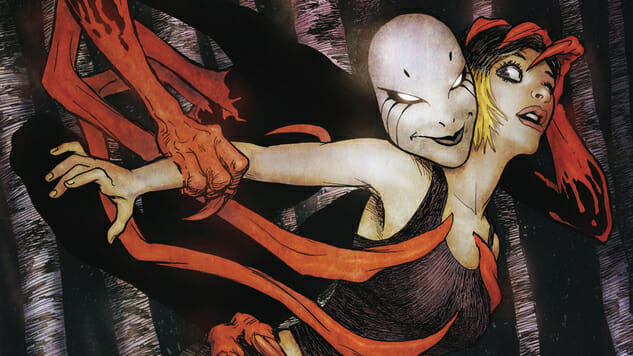
It’s a quiet week for comics as we head into the Thanksgiving holiday (or a nondescript November week if you’re reading this outside of America). There definitely isn’t the long-awaited first issue of a controversial crossover between the DC Universe and Alan Moore and Dave Gibbons’ seminal Watchmen hitting stands, nor is there the accessible first trade of the All-New Guardians of the Galaxy, in plenty of time for holiday stocking-stuffing. Gerard Way and Nick Derington’s fan-favorite Doom Patrol doesn’t return with its ninth issue, and rising star Ibrahim Moustafa doesn’t become the first writer/artist to tackle James Bond. Void Trip doesn’t kick off an interstellar stoner comedy and Moon Girl definitely doesn’t team up with half of the Fantastic Four as she enters the Legacy era. We don’t even have the mad space titan, Thanos, finally winning his fight against all life in the cosmos. Nope, just a boring, dull, uneventful week…on Opposite Day! Enjoy all of the above and more in our Required Reading picks below, and try not to spill any cranberry sauce on your floppies or digital reading devices.
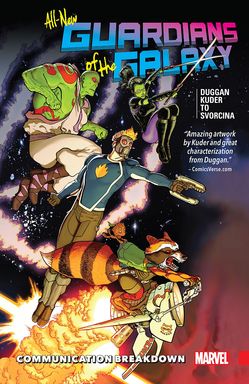 All New Guardians of the Galaxy Vol. 1
All New Guardians of the Galaxy Vol. 1
Writer: Gerry Duggan
Artist: Aaron Kuder
Publisher: Marvel Comics
If any property represents the progress that Marvel—both in comics and film—has made, The Guardians of the Galaxy should stand tall with a shit-eating grin. Before James Gunn’s 2014 film, writers Dan Abnett and Andy Lanning showed the baffling scope of Marvel’s interstellar heavens, examining just how bizarre and un-mined its fictional potential was. The core of the book has remained a lost-and-found collection of misfits uniting to foil universe-threatening catastrophe and crack goofy one-liners. After a streamlined run from Brian Michael Bendis and Sara Pichelli, writer Gerry Duggan (Arkham Manor, Deadpool) and Aaron Kuder (Action Comics) punctuated that legacy by further exploring the volatile, hilarious and dysfunctional chemistry behind the crew. This collection of their first story arc witnesses a space berserker turn pacifist and sci-fi opera mainstays the Collector and Grandmaster wage war. Both in theaters and in panels, Guardians of the Galaxy continues to be accessible, disarming fun tailored to recruit new readers. Sean Edgar
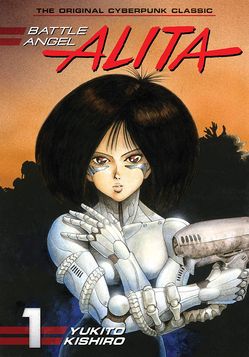 Battle Angel Alita Deluxe HC Vol. 1
Battle Angel Alita Deluxe HC Vol. 1
Writer/Artist: Yukito Kashiro
Publisher: Kodansha
November has offered a cornucopia of manga excellence; first Kodansha released the eight-book Akira 35th Anniversary Box Set, and now the publisher follows up with Battle Angel Alita Deluxe Edition Vol. 1. In terms of cyberpunk Japanese comics, this is the pie and liquor-spiked coffee following a turkey gorging. Published eight years after Akira’s debut, Yukito Kashiro’s masterwork continued to channel the automation and logistics-driven revolution occurring in ‘80s Japan. The story follows a scientist assembling a cyborg in a desolate future, and the torrent of emotion and violence that follows “her” awakening. In his review for the digital edition, Toussaint Egan wrote that “Kishiro’s aptitude for choreography and dynamic perspective layouts is unmistakable; a time-capsule of a young storyteller whose nascent talents, impressive as they were, only hint at the mastery of kineticism and detail he would later go on to exhibit.” On paper, that visual mastery is heightened. Though his designs are exaggerated and stylized, each surface holds a retina-straining degree of detail, shading and hatching that would require a reservoir of patience to execute. Artistic finesse aside, Alita is a defining comic that encapsulates a country in transition and the values boiling and simmering around it. Its historical significance elevates it to not only required reading for this week, but required reading for all sequential storytelling. Sean Edgar
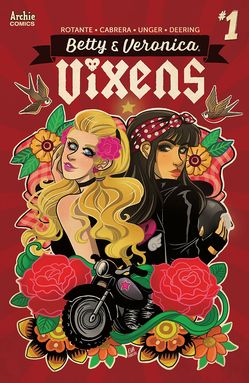 Betty and Veronica: Vixens #1
Betty and Veronica: Vixens #1
Writer: Jamie L. Rotante
Artists: Eva Cabrera
Publisher: Archie Comics
The looming question in the near-80 years of history behind Archie Comics remains poignant even today: why would two women as interesting and badass as Betty and Veronica fawn over a dude as milquetoast as Archie? The answer is they wouldn’t, and the pair is just as interesting on its own without a sappy dude singing C-level Gavin DeGraw (don’t Google him, you’re good). Fortunately, comics ranging from the old-school Archie’s Girls Betty and Veronica (sigh) to last year’s titular miniseries by writer/artist Adam Hughes feature the wrench-slinging girl next door and sassy socialite navigating Riverdale in tandem; new series Betty and Veronica: Vixens adds a ‘50s biker-gang twist to the pair’s adventures, and the Wild Ones aesthetic alone is worth a pick-up. Written by Archie editor/proofreader Jamie Rotante and illustrated by Eva Cabrera (Kim & Kim), the series promises deep characterization in a gonzo context, a trick utilized well in Robert Hack and Roberto Aguirre-Sacasa’s Chilling Adventures of Sabrina. This is Rotante’s maiden voyage into sequential storytelling, but that unencumbered outlook could lead to an especially fresh spin full of oil stains and switch-blade showdowns for comicdom’s favorite high-schoolers. Sean Edgar
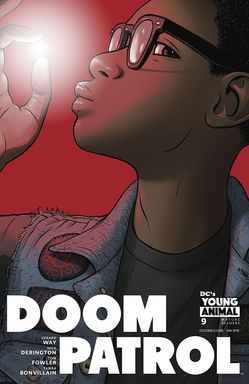 Doom Patrol #9
Doom Patrol #9
Writer: Gerard Way
Artist: Nick Derington
Publisher: Young Animal/ DC Comics
The recent Doom Patrol relaunch has beautifully merged post-modern, psychedelic trimmings with human dysfunction, all revolving around a collection of space-time castaways who can barely communicate with one another, let alone solve the multiverse’s problems. From Casey, whose parents were “created” in the first arc, to street cat Lotion, inexplicably transformed into a moody, co-dependent couch surfer, Doom Patrol has tried it damndest to give orphans of the fantastic a makeshift family. Cover character Lucius Reynolds is a more classic example of the alienated, a teenager experimenting with occult rituals in his room as his parents lament the state of their nuclear family. This issue hints that he may conjure more than insomnia, but with any script written by Umbrella Academy pioneer Gerard Way, only expect the unexpected. The writer’s plot beats dismantle and reassemble like Allen Ginsberg poetry, unafraid to ask more from the reader as they pivot around daring concepts and a shifting ensemble. Artist Nick Derington continues to illustrate the unfathomable, rendering alternate-universe violations with clarity and energy, making him the perfect fit for this high-concept descent. Sean Edgar
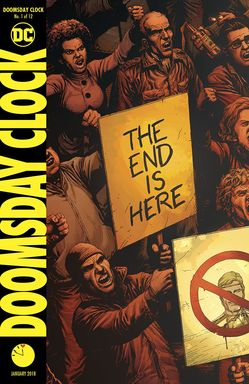 Doomsday Clock #1
Doomsday Clock #1
Writer: Geoff Johns
Artist: Gary Frank
Publisher: DC Comics
No matter whether you think a sequel should exist to one of the most lauded comics of our generation, credit DC Comics President/Chief Creative Officer Geoff Johns with the gumption to go big or go home. Unlike the Before Watchmen prequels that ran in 2012, this new 12-issue maxi-series stems directly from Alan Moore and Dave Gibbons’ seminal, gritty masterpiece. The latter has stood as a pillar of literary comics since its 1986 release, featuring a gaggle of washed-up heroes contemplating the greater good in a society on the brink of nuclear annihilation. The challenge for Johns and artist Gary Frank will be to take a grand, meta commentary on the ‘80s and shift it into today’s context. Also included: a universe-bridging crossover featuring DC’s greater pantheon. That’s a lot to digest, especially following Grant Morrison and Frank Quitely’s excellent Pax Americana issue of The Multiversity, which summarized the greater themes and sci-fi grandiosity of Watchmen in 40 pages. Ideally, Johns will use this as a platform to comment on the political volatility of 2017 à la Mister Miracle, with the stakes just as high and the fallout just as bittersweet as can be with Superman floating in the background. Check out our interview with Frank later this week for more insight into Doomsday Clock. Sean Edgar
 Imaginary Fiends #1
Imaginary Fiends #1
Writer: Tim Seeley
Artist: Stephen Molnar
Publisher: Vertigo/ DC Comics
Vertigo’s latest foray into horror is ripped from the headlines with all the subtlety of a very special Law & Order: SVU episode, with an opening premise lifted wholesale from the disturbing attempted murder of 12-year-old Payton Leutner in 2014. Two of Leutner’s classmates stabbed the girl as an offering to the fictional internet boogeyman known as Slenderman, kicking off a furor of discussion around unsupervised internet consumption, violent storytelling and the line between reality and fiction. Writer Tim Seeley and artist Stephen Molnar posit that the girls who committed the atrocious act may have actually been under the sway of a creature only they could see—Polly Peachpit in this telling—which primes one of the almost-murderers to use her special spectral buddy to combat even worse “imaginary fiends.” Seeley quickly pivots the book away from outright horror to more of a supernatural police thriller vibe, which fits neatly within Vertigo’s recent oeuvre. Molnar provides a grounded take on the book’s human elements and sufficient imagination in conjuring up the invisible beasties whispering in the ears of impressionable young folks. Fans of internet urban legends and police procedurals should get a spider-legged kick out of this mini-series. Steve Foxe
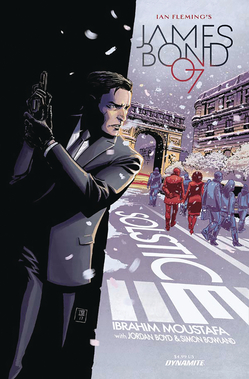 James Bond: Solstice One-Shot
James Bond: Solstice One-Shot
Writer/Artist: Ibrahim Moustafa
Publisher: Dynamite Entertainment
James Bond: Solstice is a first for Dynamite’s tenure with the Bond license: a writer/artist taking on 007 solo. The cartoonist in question is Ibrahim Moustafa, a graduate of DC’s talent workshop, the artist on recent Vertigo series Savage Things and the co-creator of the Eisner-nominated High Crimes with Christopher Sebela. It speaks to Dynamite’s confidence in Moustafa that Solstice is one of his first high-profile writing gigs, but the publisher has yet to do wrong by Ian Fleming’s famous creation. Even if Moustafa’s plot about Russians in Paris doesn’t land a headshot, he’s easily one of the most accomplished artists to take a crack at the character currently portrayed on screen by Daniel Craig. Steve Foxe
 Moon Girl & Devil Dinosaur #25
Moon Girl & Devil Dinosaur #25
Writer: Brandon Montclare
Artist: Natacha Bustos
Publisher: Marvel Comics
It looks like Marvel isn’t quite ready to give readers a proper Fantastic Four book again, but between teases in the Legacy one-shot, the upcoming Marvel Two-in-One series and Moon Girl & Devil Dinosaur’s first arc of the Legacy era, fans of Marvel’s First Family are finally getting a cosmic-ray-exposed bone thrown their way. Preteen super-genius Lunella Lafayette is separated from her scaly red buddy, and teams up with Johnny Storm and Ben Grimm to help them tackle a cosmic threat as a sort of “Fantastic Three.” Writer Brandon Montclare, no longer splitting duties with Amy Reeder, and original artist Natacha Bustos have consistently provided Marvel with ones of its best accessible reads, as well as some of its freshest cartooning. The Human Torch and the Thing are just fantastic flaming and blue-eyed (respectively) cherries on top at this point. Steve Foxe
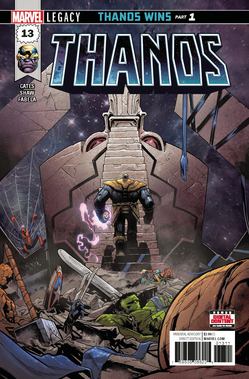 Thanos #13
Thanos #13
Writer: Donny Cates
Artist: Geoff Shaw
Publisher: Marvel Comics
Donny Cates’ high-profile ascent at Marvel continues this week, and he’s brought his God Country collaborator Geoff Shaw along for the ride. Thanos has long been one of Marvel’s biggest bads, made even bigger by his slow-burn hover across the Marvel Cinematic Universe. Attempts at a solo series for the purple, death-obsessed space god have struggled, though—Thanos may simply be most compelling as an apocalyptic threat and not as a student (in Jason Aaron and Simone Bianchi’s run) or while dealing with family drama (in the first 12 issues of this series, scripted by Jeff Lemire). Good thing Cates and Shaw are going for broke, then. Their inaugural arc is titled “Thanos Wins,” and picks up with the Mad Titan having accomplished his terrible goals. As Shaw proved in the pages of God Country, there are few rising talents better equipped to show deity-level destruction, making this the most promising solo Thanos outing in modern memory. Steve Foxe
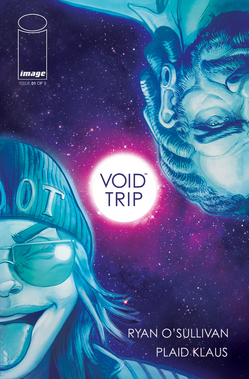 Void Trip #1
Void Trip #1
Writer: Ryan O’Sullivan
Artist: Plaid Klaus
Publisher: Image Comics
Gastronomy detective tale Chew was one of Image’s first great success stories following The Walking Dead’s astronomical rise, but few breakout series since have tackled genre-influenced comedy in the same un-self-conscious way. Ryan O’Sullivan and Plaid Klaus’ Void Trip seems to channel some of that bold humor with its space-stoners premise, as a pair of intergalactic hobos searches for a promised land for hippies among the stars. Solicits for future issues suggest this won’t go as well as planned (what drug trip ever does?), but the Void Trip creative team knows how to take a dark turn when necessary: O’Sullivan wrote the Evil Within tie-in comics for Titan and previously collaborated with Klaus on superhero-killer thriller Turncoat. Steve Foxe